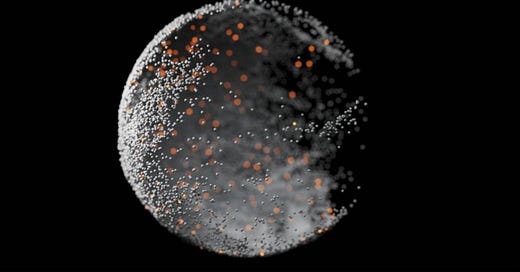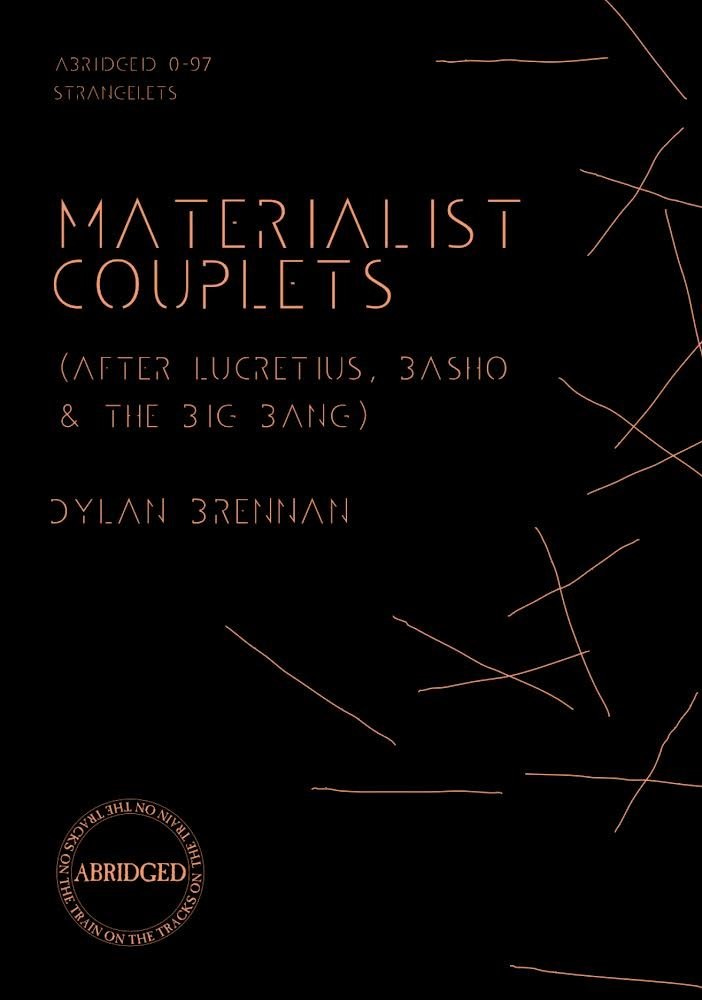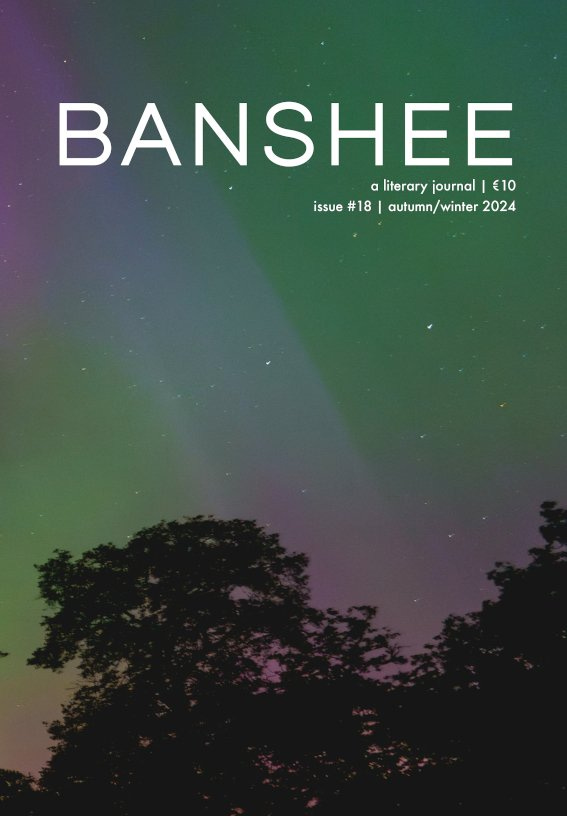three quarks for Muster Mark
we’re all down here just fumbling in the dark
A while back I received an email asking me if I’d like to write a few pages of poetry on the theme of the ‘Strangelet’, ‘a hypothetical particle that could destroy the universe’. I didn’t take much convincing. While I know little about physics, I have some experience of discussing things like dark matter in a classroom setting from my time as a Theory of Knowledge teacher. I was intrigued. I knew this would push me into unexpected territory. Intuition is important but it won’t get you very far in the realm of theoretical physics, the numbers are too huge, the distances too vast. Imagination, on the other hand, is essential. Along with mathematics, of course. Anyway, after a lot of thinking, research, videos on YouTube and a few TED Talks, I decided to go back to the beginning, sort of. I don’t know if Lucretius was the first to write a poem that attempted to explain the universe, but it was the first one I’d heard of. His De Rerum Natura, (‘On the Nature of Things’) is a 7,500 line poetic exploration of the theories of Epicurus, a rather austere materialist philosophy that has little to do with contemporary meanings of ‘Epicurean’. It is, also, a philosophy that attempted to ease the suffering of those who fret about our ultimate demise with the immortal assertion that ‘Death is nothing to us; it concerns us not a jot’ for the reason that ‘Nothing can befall us, we who shall no longer be, / Nor move our senses, no, not even if the earth and sea / Were confounded with on another, and the sea mixed with the sky’. Richard Jenkyns, in his introduction to the edition I read, explains the Epicurean/Lucretian attitude towards death as follows: ‘Mind and soul are purely material, and death is merely the dissolution of a temporary combination of atoms.’ Here’s a bit more on this topic, in A.E. Stalllings’ translation:
And let’s say even after they were ripped out of our body
The mind and spirit could feel. Well, so what? That does not mean
Anything to us, a cobbled coupling between
The spirit and the flesh. And even if time could somehow
Gather our atoms together after death as they are now,
And we were blessed with the light of life again — it wouldn’t matter
Anything to us, not once our recollections scatter
That connect us with our former selves. And what we were before
Is no concern to us as we are now, nor any more
Are we haunted by their former sufferings. For when you cast
Your gaze back over the whole immeasurable span of ages past,
And consider matter’s motions, a diversity so vast,
It’s easy to believe that these same seeds of which we’re made
In the here and now have in the past been frequently arrayed
In the same way, although we can’t remember it because
A caesura has been cast between those different lives, a pause,
And the motions of their consciousness have wandered far astray.
Perhaps the whole idea can be summed up with the statement that ‘he who is not cannot be wretched or forlorn’. If you don’t exist, you don’t suffer. A bit bleak though, all the same. Anyway, much of the Lucretius poem is concerned with atoms and an earnest plea for readers to pay more attention to scientific-based evidence than religion and superstition. As I read I started to think and write in couplets. I combined images from Lucretius with other texts I had been reading at the same time. Basho’s Haibun, in particular, and Marx and scientific texts about quarks and the like. I saw a similarity in the behaviour of strangelets and cancer cells and researched the Cancer constellation. I loved that ‘Quarks’ came from the jubilant chaos of Joyce’s Finnegans Wake and even wrote one couplet inspired by the appearance of the word in his final novel (see top of the page). I discarded that one (and many others), the tone was off, but enjoyed writing it. I also wanted to interrogate the notion of the purely physical. What about ghosts? All this led to the composition of 40 couplets that have some connection to ideas about nature and the cosmos. A strange energy. I really enjoyed the whole process and the culmination is Materialist Couplets (after Lucretius, Basho and The Big Bang) an e-pamphlet published by abridged. You can read it for free here. (I find it works better on a larger screen, i.e. an iPad or Laptop, rather than on a phone). You can find a fuller description of the project, as well as work by the other four poets commissioned for the Strangelets project (Jessica Traynor, Tara Bergin, Aoife Mannix and Dimitra Xidous) here.
In other news, I was interviewed for the RTÉ One radio programme Poetry People over the summer. I read from Let the Dead and discussed it with presenter Rachael Hegarty. It aired yesterday and you can listen back here. As we recorded in July, I wasn’t really expecting questions about Day of the Dead and would’ve provided more coherent responses closer to November. Or maybe I wouldn’t have, who knows. Either way, I enjoyed the conversation and hope it will bring a new reader or two to my work. Many thanks to both Rachael and producer Yetti.
If you see a monarch on the Day of the Dead, you should be silent, for your departed bring tidings in the beating of its wings. I have a poem in the new issue of Banshee. It was inspired by the work of Homero Gómez González, murdered protector of the monarch butterflies. There’s more to say about this but I’d rather you just read the poem. It looks like a great issue and, as I read and loved both of their books last year, I’m particularly interested to read the selections made by guest editors Molly Hennigan (non-fiction) and Rosamund Taylor (poetry). You can buy the new issue of Banshee here.
News of some other publications coming soon. Also, if you happen to be in Guadalajara, I’ll be at the FIL in early December. All the best for now.
As always, you can subscribe for free, please do. Any likes, shares for this and for Materalist Couplets are greatly appreciated. And, as always, you can buy a copy of Let the Dead here.






